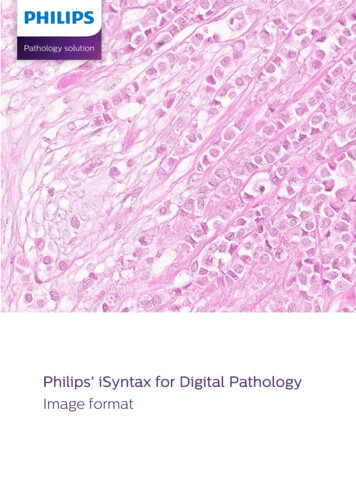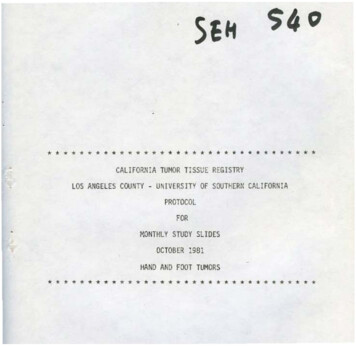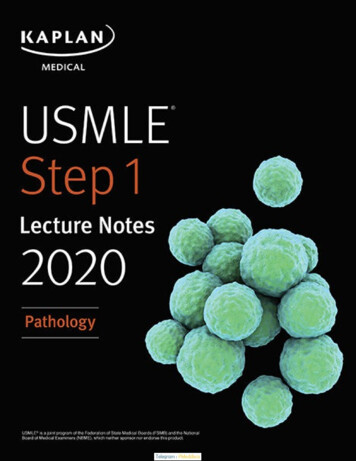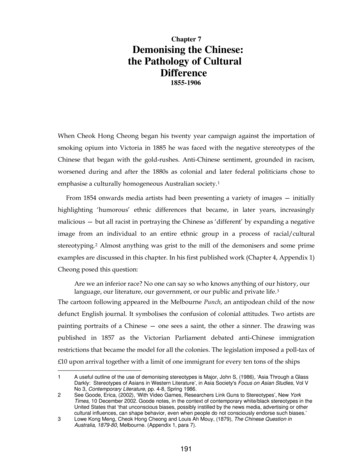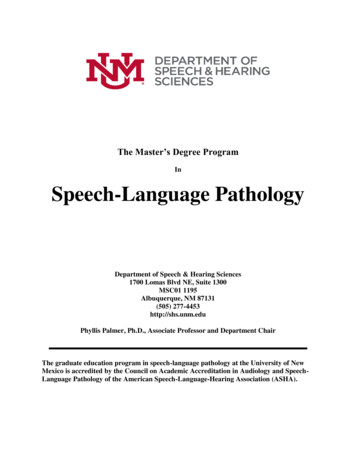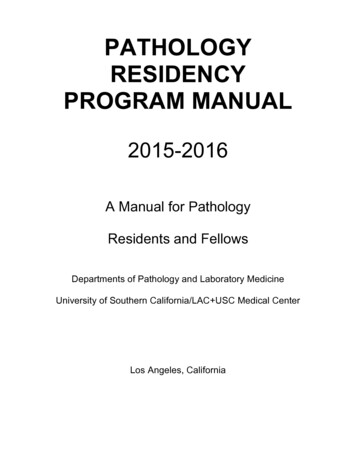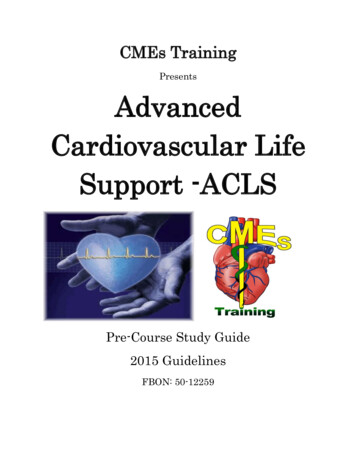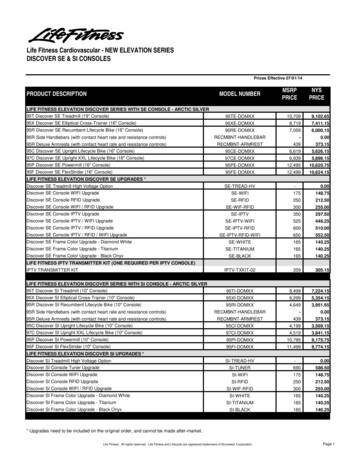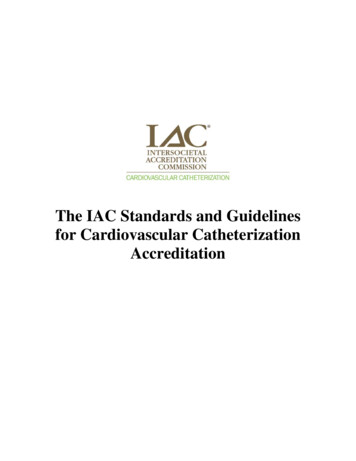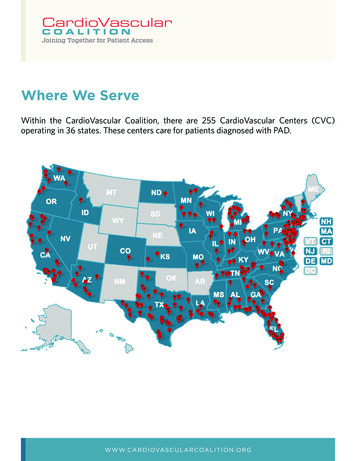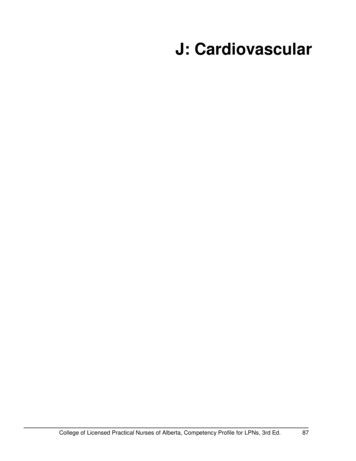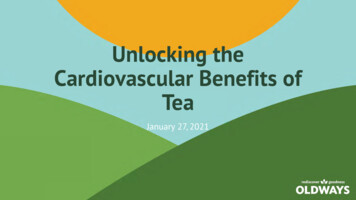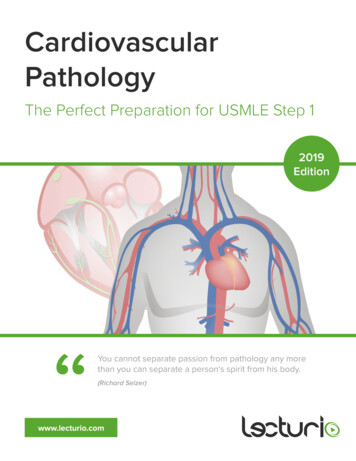
Transcription
CardiovascularPathologyThe Perfect Preparation for USMLE Step 12019EditionYou cannot separate passion from pathology any morethan you can separate a person‘s spirit from his body.(Richard Selzer)www.lecturio.com
Cardiovascular Pathology eBookLive as if you were to die tomorrow.Learn as if you were to live forever.(Mahatma Gandhi)Pathology is one of the most tested subjects on the USMLE Step 1 exam. At the heart of the pathology questionson the USMLE exam is cardiovascular pathology. The challenge of cardiovascular pathology is that it requiresstudents to be able to not only recall memorized facts about cardiovascular pathology but also thoroughly understand the intricate interplay between cardiovascular physiology and pathology. Understanding cardiovascularpathology will not only allow you to earn a high score on the USMLE Step 1 exam but it will also serve as the foundation of your future patient care.This eBook. .will provide you with everything you need to know about cardiovascular pathology for yourUSMLE Step 1 exam. .will equip you with knowledge about the most important diseases related to the cardiovascular system,but will also build bridges to the related medical sciences, thus providing you with the deepest understanding of all cardiovascular pathology topics. .is especially for students who already have a strong foundation in the basic sciences such as anatomy,physiology, biochemistry, microbiology & immunology, and pharmacology.High-yield:Murmurs of grade III and above are usually pathological.Thrills are palpale murmurs,and can only be felt in murmurs of grade IV and above.High-yield-information will help you to focus on the mostimportant facts.A number of descriptive pictures, mnemonics andoverviews, but also a reduction to the essentials,will help you to get the best out of your learning time.Did you not only read the section but also understand it?Our review questions ensure your learning success.EXPLORE THIS TOPICWITH OUR VIDEOS!Whether you have not yet understood somethingperfectly, or whether you want to deepen your knowledge. Inour videos our lecturers explain the whole thing to you once again.
Lecturio Makes High Scores Achievable for All Students!LEARN AND REVIEW CONCEPTS FASTER, EASIERVideo LecturesShort, concise and easy-to-follow video lecturesdelivered by award-winning professorsAll key concepts covered in depth, emphasizing highyield informationIntegrated quiz questions for active learningAPPLY CONCEPTS WITH CONFIDENCEQuestion BankLecturio’s Question Bank is based on the latestNBME standards and teaches you to effectivelyapply what you have learnedSupporting explanations and illustrations allow youto practice multistep critical thinkingAn exam-simulating interface helps you becomefamiliar with actual test situationsMEMORIZE KEY INFORMATION BETTER, SMARTERSpaced Repetition QuizImprove your ability to recall key information –even under pressureAn adaptive algorithm tells you exactly when andwhat you need to repeatStay on track with regular notifications forquestions dueCREATE YOUR FREE ACCOUNT
Table of ContentsIntroductionChapter 1: Heart SoundsMost Important Facts about Heart SoundsPractical Guide to Cardiovascular Examination7–1819–23Chapter 2: HypertensionMost Important Facts about Hypertension25–37Chapter 3: AtherosclerosisMost Important Facts about 8–51Chapter 4: Ischemic Heart DiseaseMost Important Facts about Ischemic Heart Diseases53–59Stable Angina60–64Vasospastic Angina65–71Acute Coronary Syndrome (ACS)72–81Unstable Angina82–83Myocardial Infarction — NSTEMI vs. STEMI84–92Chapter 5: Valvular Heart DiseaseMitral Valve Prolapse (Barlow Syndrome)94–98Mitral Stenosis (Mitral Valve Stenosis)99–105Mitral Insufficiency (Mitral Regurgitation)106–112Aortic Stenosis (Aortic Valve Stenosis)Aortic Insufficiency (Aortic Regurgitation)113–119120–126
Table of ContentsChapter 6: Congestive Heart FailureCongestive Heart Failure128–139Cardiogenic Pulmonary Edema140–145Chapter 7: Pericardial DiseaseAcute Pericarditis147–153Constrictive Pericarditis154–160Pericardial Effusion And Cardiac Tamponade161–169Chapter 8: ArrhythmiaAnatomy of the Electrical System of the Heart171–173Most Important Facts about Arrhythmia174–178Atrial Fibrillation (AFib)179–188Bradyarrhythmias189–195Atrial Flutter196–201Multifocal Atrial Tachycardia (MAT)202–206Wolff-Parkinson-White (WPW) Syndrome207–214Ventricular Tachycardia (VT)215–222Chapter 9: Common Vascular DisordersAortic Dissection (AD)224–235Peripheral Artery Disease (PAD)236–244References & Image AcknowledgementsGIVE US YOUR FEEDBACK!Help us improve your learning experience!
IntroductionCardiovascular diseases are conditions that affect different structures of the heart, ranging from vasculardisorders such as coronary and peripheral arterial diseases, to cardiac disorders based on the affectedanatomical structure of the heart. Ischemic heart disease (IHD) is the leading cause of death and disabilityworldwide and can be prevented by lifestyle changes such as quitting smoking, exercising and following ahealthy diet, and correcting its risk factors such as diabetes, dyslipidemia, and obesity in their early stages.IHD can range from asymptomatic coronary heart disease, through to stable/unstable angina and myocardialinfarction, with several consequences such as chronic heart failure, arrhythmias, and even death. Valvularheart diseases are also common in practice, taking the forms of stenosis, insufficiency, or a combinationof the 2. These structural changes result from either underlying congenital conditions or acquired causes,including infections, ischemic heart disease, or degenerative processes. The type of valvular disease isdetermined by the levels of ongoing cardiac stress and the severity of presenting symptoms. In this eBook,we will describe the different cardiovascular disorders in detail, providing a high-quality review for yourUSMLE exam.
Chapter 1:Heart Sounds
Chapter 1: Heart SoundsGeneral IntroductionEXPLORE THIS TOPIC WITH OUR VIDEOS!
Chapter 1: Heart SoundsTypes, Origins and Timing of Heart SoundsOn auscultation, 2 heart sounds are heard from a normal heart, which are described as the first and secondheart sounds. Additional heart sounds may be present, namely the third and fourth heart sounds. Furthersounds such as murmurs may also be heard upon auscultation of the heart.120Pressure (mm Hg)100806040200Heart soundsFig. 1-01: Heart Sounds and the cardiac cycleFirst and second heart soundsThe closure of the heart valves produces vibrations that are picked up as the 2 heart sounds.The first heart sound, S1, corresponds with the closure of the atrioventricular valves – the tricuspid andmitral valves of the heart. S1 represents the start of ventricular systole. The closure of the mitral valves precedes the closure of the tricuspid valves; however, the time between them is minimal so that S1 is usuallyheard as a single sound. S1 is best heard at the apex of the heart.The second heart sound, S2, corresponds with the closure of the semilunar valves – the aortic and pulmonary valves of the heart. S2 signifies the end of ventricular systole and the beginning of diastole.Compared to the first heart sound, S2 is shorter, softer, and slightly higher in pitch. A reduced or absent S2indicates pathology due to an abnormal aortic or pulmonic valve.9
Chapter 1: Heart SoundsFig. 1-02: (A) Heart sound S1 (B) Heart sound S2The aortic valves shut before the pulmonary valves. This is due to lower pressures in the pulmonarycirculation which allows blood to continue flowing into the pulmonary artery after systole ends in the leftventricle. In 70 % of normal adults, this difference can be heard as the splitting of the second heart sound.The pulmonary component of S2 is referred to as P2; the aortic component is called A2. Splitting is bestheard in the pulmonary area (second left intercostal space) and at the left sternal edge.Splitting of the second heart sound1) Physiological splitting of S2: Inspiration delays closure of the pulmonary valves by about 30—60 milliseconds due to increasedvenous return and decreased pulmonary vascular resistance. This is called the physiological splitting of S2.2) Abnormal splitting of S2: Wide splitting of S2: An exaggerated (persistent) physiological split that is more pronouncedduring inspiration. Fixed splitting of S2: Fixed delay of P2 closure due to increased right-sided volume (ASD or advancedRV failure). Reversed or paradoxical splitting of S2: Aortic valve closure delayed due to obstruction (AS) orconduction disease (LBBB). Split narrows with inspiration as pulmonic valve closure is delayedmoving P2 closer to a delayed A2 where the sound becomes single.10
Chapter 1: Heart SoundsANormalS1PersistentReversed/ParadoxicalA2 P2S1S1S1A2 A2P2P2OppositeS1S1S1S1A2 P2A2 P2S1S1A2P2A2 A2 P2P2P2Oppositedelayed longerFixedNormalReversed/ParadoxicalA2 P2A2P2No changeHigh-yield:S1P2 A2OppositeS1P2 A2Absent splitting of S2 can beseen in:OppositeB Severe aortic stenosis(in elderly patients) VSD with Eisenmengersyndrome (in pediatricpatients)Fig. 1-03: (A) Types of abnormal splitting of S2 are wide, fixed and paradoxicalsplitting (B) Heart soundsExtra Heart SoundsThird heart sound (S3)Extra heart sounds include the third and fourth heart sounds. The thirdheart sound (S3) is a mid-diastolic, low-pitched sound. With the presence of S3,heart sounds are described as having a gallop rhythm, simply because its additionalongside S1 and S2 make it sound like a horse galloping. S3 occurs after S2,during the rapid passive filling of the ventricle.A physiological S3 is produced when there is rapid filling during diastole as canhappen in conditions which increase cardiac output such as thyrotoxicosis andpregnancy; this might also be a pediatric finding. On the other hand, a pathologicalS3 is produced when there is decreased compliance of the ventricle (dilatation oroverload), causing a filling sound.Causes of a pathological S3 include conditions that reduce left ventricularcompliance, such as left ventricular failure, left ventricular dilation, aortic regurgitation, mitral regurgitation, patent ductus arteriosus, and a ventricular septal defect.Conditions with reduced right ventricular compliance can also cause apathological S3. These include right ventricular failure and constrictive pericarditis.11
Chapter 1: Heart SoundsAInaudible S3 (normal)S1Audible S3 (may be abnormal)S2S1S2S3 Heart soundBInaudible S4 (normal)S1Audible S4 (usually abnormal)S2S1S2S4 Heart soundFig. 1-04: (A) Heart sound S3 (B) Heart sound S4Fourth heart sound (S4)The fourth heart sound (S4) is a late diastolic sound. It is of a slightly higher pitch than S3. S4 also soundssimilar to a triple gallop rhythm. S4 occurs slightly before S1 and is associated with atrial contraction andrapid active filling of the ventricle.S4 is caused by decreased ventricular compliance. Reduced left ventricular compliance, as in aortic stenosis,mitral regurgitation, hypertension, angina, myocardial infarction, and old age, can produce an S4.Reduced right ventricular compliance, as in pulmonary hypertension and pulmonary stenosis, can similarlycause an S4.It is possible for the third and fourth heart sounds to co-exist, in which case this is called a quadruplerhythm. This indicates significantly impaired ventricular function. If S3 and S4 are superimposed when tachycardia is present, a summation gallop is produced.12
Chapter 1: Heart SoundsMurmursA murmur is a sound produced by turbulentblood flow across a heart valve. Turbulentflow can occur due to 2 reasons: firstly,when the blood flows across an abnormalheart valve, and secondly when an increasedamount of blood flows across a normal heartvalve. Heart murmurs may be classified as physiological or innocent, with pathologic murmursbeing based upon the cause of the turbulence.A physiological murmur is heard when thereis an increased turbulence of blood flowacross a normal valve, as can happen in theconditions thyrotoxicosis and anemia, as well asduring fever and exercise. Physiologic murmurs arealways systolic murmurs, as increased bloodflow occurs during ventricular systole. They aremore likely to be found in young people. Innocentmurmurs also have the qualities of being soft, short,early peaking, mostly confined to the base of theheart, having a normal second heart sound, andgenerally disappearing with a change in position.The rest of the cardiovascular exam is normal incases of physiologic murmur.Fig. 1-05: Phonocardiograms from normal andabnormal heart soundsPathologic murmur occurs when there isturbulence of blood flow across an abnormal valve.This can be due to either stenosis or regurgitation.StenosisStenosis refers to the abnormal narrowing of a valve orifice. The narrowing of a valve prevents it fromopening completely; as a result, stenosis murmurs can only occur when the valve is attempting to open.RegurgitationRegurgitation refers to the abnormal backward flow of blood from a high-pressure chamber to a low-pressurechamber, often due to an incompetent valve (i.e. a valve that cannot shut properly).Systolic murmursSystolic murmurs are murmurs that are produced during systole (contraction) of the ventricles, which is theperiod between S1 and S2. These murmurs can be midsystolic (ejection), late systolic, and pansystolicmurmurs. Systolic murmurs can be either normal or abnormal.Midsystolic ejection murmursMidsystolic ejection murmurs have their highest intensity in the middle of systole. They are often describedas having a crescendo-decrescendo quality. This can be a physiological murmur, caused by an increasedflow through a normal valve; or, it can indicate pathologies, such as aortic stenosis or pulmonary stenosis. Incases of congenital aortic or pulmonary stenosis, an early high-pitched systolic ejection click may be heard,representing the sudden opening of these
At the heart of the pathology questions on the USMLE exam is cardiovascular pathology. The challenge of cardiovascular pathology is that it requires students to be able to not only recall memorized facts about cardiovascular pathology but also thoroughly un-derstand the intricate interplay between cardiovascular physiology and pathology. Understanding cardiovascular
